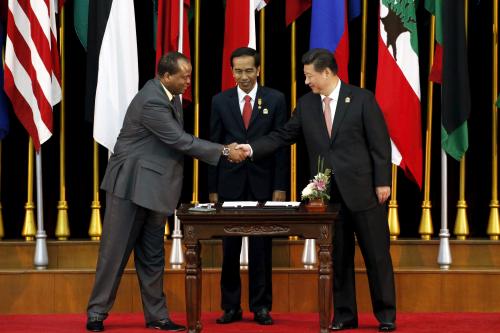Just one year ago, on April 18, 2018, China formally established its first independent foreign aid agency: the China International Development Cooperation Administration (CIDCA). Attention from top leadership attested to the importance of this new agency: The opening ceremony was chaired by Politburo member Yang Jiechi and attended by State Councilor and Foreign Minister Wang Yi, the two most senior foreign policy officials of China. The establishment of CIDCA addresses a long debate in China about its foreign aid reform and the creation of an independent aid agency.
However, one year into its creation, has CIDCA begun to make a difference? An examination of its mandate and setup reveals a genuine effort by China to reform and improve its aid practices. However, a scrutiny of the foreign aid budget allocation suggests that CIDCA will have a long way to go to take full charge, if it ever will. CIDCA might have become the face of China’s foreign aid for the foreign audience, and it might participate extensively in the coordination of aid decisions; however, the internal bureaucracy dictates that money, hence the authority, still lies elsewhere.
Long desired aid reform coming to fruition
The creation of CIDCA originates from a long debate around which national interests China’s foreign aid should prioritize and, therefore, which government agency should manage the aid portfolio. Before CIDCA, the administrative office of China’s foreign aid sat within the Ministry of Commerce (MOFCOM) as the Department of Foreign Aid, a director-general-level institution. With this bureaucratic design, the Ministry of Foreign Affairs (MFA) was discontent, as aid decisions were believed to have skewed toward commercial interests rather than toward the broader strategic interests of China. The fact that the majority of Chinese aid has been used for concessional loans seems to support this argument. In its 2014 Foreign Aid White Paper, China acknowledged that 55.7 percent of its foreign aid between 2010 and 2012 had been used for concessional loans.
The bureaucratic setup of the new CIDCA seems to be a continuity of the country’s commercial focus towards foreign aid. The bureaucratic ranking of CIDCA is set at the vice-ministerial level. The director, Wang Xiaotao, was the former deputy director of the National Development and Reform Commission, China’s top economic policymaking organ. The first two deputy directors of CIDCA came from MOFCOM and the MFA, respectively, reflecting the two pillars China’s foreign aid has been and continues to be anchored on. In particular, Deputy Director Zhou Liujun used to be in charge of service trade and foreign direct investment at MOFCOM. In comparison, the deputy director from the MFA, Deng Boqing, was Chinese ambassador to Nigeria. In early 2019, a third deputy director—former deputy director of the National Intellectual Property Administration, Zhang Maoyu—was added to CIDCA’s leadership, which suggests an emphasis on intellectual property issues within the framework of China’s foreign aid.
Mandates: The old and the new
CIDCA’s mission statement suggests subtle yet important distinctions in its mandate and authority in comparison with its previous incarnation as the Department of Foreign Aid at MOFCOM. Instead of the implementation of specific projects, CIDCA is geared more toward the strategic design, management, and interagency coordination of China’s foreign aid administration. For example, the 2018 Draft Foreign Aid Management Methods identified new tasks for CIDCA including strategic planning, monitoring and evaluation, aid reform, and budget preparation.
Another key distinction lies in the concrete project implementation side: Although CIDCA is responsible for the planning and coordination of foreign aid, it is not responsible for their implementation. The implementation will remain the responsibility of the individual relevant functional agencies, such as the Ministry of Commerce and the Ministry of Agriculture. Furthermore, CIDCA is responsible for developing country strategies and signing aid projects as the face of China’s foreign aid. In the “Cooperation Activities” section of CIDCA’s website, seven bilateral cooperation agreements were listed between June and December of 2018 where CIDCA signed economic development agreements on behalf of China. CIDCA has already had active engagement with multilateral institutions such as the United Nations and World Bank, as well as traditional donors such as the U.K., EU, Australia, and Norway.
Foreign aid budget: NOT under CIDCA’s control
The creation of CIDCA raises the question of the structure of decisionmaking and budget allocation, which determines the center of gravity of China’s foreign aid. Indeed, if CIDCA doesn’t control the money, its control of the aid decisions will be subject to serious constraints. Most importantly, China’s concessional loans, which make up the majority of its foreign aid, are traditionally managed by the China Export-Import Bank.
As of now, there is no definitive answer to this question, as many issues related to CIDCA’s operation are still in flux within the Chinese bureaucracy. However, numbers do not lie, and the budget allocation among government agencies offers the best assessment.
According to the 2019 CIDCA budget, the total foreign aid budget under CIDCA for 2019 is 122 million RMB (about $18 million), up from 105 million RMB ($15 million) in 2018. In 2018, there was no budget allocated for international development cooperation, but in 2019 this budget line increased to 74 million RMB ($11 million). CIDCA’s explanation for this increase is its adjustment of the budget previously listed under trade and commercial affairs, now under international development cooperation. The combined total of these two budget lines, termed “foreign affairs expenses,” are 197 million RMB (around $29 million).
These numbers come as a shock given how tiny they are. The 2014 Foreign Aid White Paper disclosed that China’s foreign aid from 2010 to 2012 was 89.3 billion RMB—around 30 billion RMB ($4.6 billion), per year. We can only assume that China’s total foreign aid has, in fact, increased since then, especially under the Belt and Road Initiative launched in 2013. The tiny budget CIDCA gets vis-à-vis China’s much larger foreign aid spending can point to only one possibility: that the bulk of China’s foreign aid budget is parked and managed somewhere beyond CIDCA.
Where is the bulk of the foreign aid budget? The 2019 MOFCOM budget brings the answer. Although CIDCA is established as China’s aid agency, the foreign aid budget of MOFCOM in 2019 is as high as 17.6 billion RMB, around $2.63 billion, which is more in line with China’s annual foreign aid spending. Although nominally MOFCOM should be transferring the foreign aid portfolio to CIDCA, its foreign aid budget in fact has increased by 6.53 percent since 2018, when the transition supposedly began. MOFCOM might eventually transfer the authority and budget to CIDCA. However, the fact that CIDCA’s foreign aid budget is 1 percent that of MOFCOM in 2019 raises serious questions that the aid authorities, especially those on specific projects are not under CIDCA’s purview.
Implications for Africa
CIDCA represents a long-desired evolution of China’s foreign aid practice. The emphasis on strategic planning, interagency coordination, monitoring, and evaluation reflect efforts and progress in modernizing China’s foreign aid, its pursuit of better practice, as well as engagement with traditional donors. In the long run, better practice of Chinese foreign aid projects is supposed to contribute to Africa’s social and economic development. The familiarization with the norms and standards of the field will also bring opportunities for donor cooperation and coordination between China and the traditional donors. These could potentially all be good news for Africa. However, Africa should also understand that the establishment of CIDCA does not indicate a total abandonment of China’s current aid practice and the majority of the aid projects and their budget are still being made at MOFCOM. CIDCA is one additional player with whom Africa will need to learn to deal and navigate bureaucratic politics.





Commentary
One year on, the role of the China International Development Cooperation Administration remains cloudy
April 30, 2019